ECS P67H2-A Review: A visit back to Lucid's Hydra
by Ian Cutress on July 21, 2011 9:00 AM EST- Posted in
- Motherboards
- Lucid
- P67
- ECS
Board Features
| ECS P67H2-A | |
| Market Segment | Performance |
| CPU Interface | LGA 1155 |
| CPU Support | i3/i5/i7 Sandy Bridge |
| Chipset | P67 |
| Base Clock Frequency | 100 MHz by Default, 38.1 MHz to 655.35 MHz |
| DDR3 Memory Speed | 1333 MHz by Default, 1067 MHz to 2133 MHz supported |
| Core Voltage | -200 mV to +630 mV offset |
| CPU Clock Multiplier | CPU Dependent |
| DRAM Voltage | -200 mV to +630 mV offset |
| DRAM Command Rate | Auto, 1T or 2T |
| Memory Slots |
Four DDR3-DIMM Maximum 16 GB, Non-ECC Unbuffered 1067, 1333, 1600, 1867 and 2133 MHz supported |
| Expansion Slots |
3 x PCIe x16 (x16/x16/x0 or x16/x8/x8) 2 x PCIe x1 2 x PCI |
| Onboard SATA/RAID |
2 x SATA 6 Gbps (RAID 0, 1, 5, 10) 4 x SATA 3 Gbps (RAID 0, 1, 5, 10) 2 x eSATA 6 Gbps (Marvell 88SE9128) |
| Onboard |
2 x SATA 6 Gbps 4 x SATA 3 Gbps 3 x Fan Controllers 4 x USB 2.0 headers 1 x USB 3.0 header Power/Reset buttons Debug LED Front Panel Audio header SPDIF output header Serial Port header Front Panel header |
| Onboard LAN | Dual RealTek RTL8111E Gigabit Fast Ethernet Controllers with Teaming |
| Onboard Audio | Realtek ALC892 8-Ch High Definition audio CODEC |
| Power Connectors |
1 x 24-pin ATX 1 x 8-pin 12V |
| Fan Headers |
1 x CPU 1 x SYS 1 x PWR |
| IO Panel |
4 x USB 3.0 Ports (NEC Controllers) 6 x USB 2.0 Ports 1 x PS/2 Port 2 x Gigabit Ethernet 2 x eSATA 6 Gbps 1 x Clear CMOS button 1 x Optical SPDIF output Audio Jacks |
| BIOS Version | 08/04/2011 |
| Warranty Period | 3 Years |
In The Box
6 x locking SATA 6 Gbps cables
USB 3.0 Front Panel
Driver CD
Manual
Quick Start Guide
Nothing too much out of the ordinary from the box bundle - at this level, the USB 3.0 Front panel should be standard (even if you can't use it with two full length GPUs in there), and ECS fill their box with enough SATA cables to plug a drive into every internal SATA port.
Software
We’ve previously looked at ECS’ software package in our coverage of the ECS P67H2-A2 and the ECS H67H2-M. Not much has changed - even the issues I found are still here. For example, the BIOS Live Update utility did not detect the latest version on the website, so I had to search for it manually, the BCLK can only be changed with the right BIOS option enabled, and as the voltage continually switches between states, actually setting it in the OS can be hazardous if you set the idle state high (so the load state goes even higher) or set the load state low (so the idle state goes even lower) - this is all due to the BIOS using voltage offsets, rather than actual values.
eSF (Smart Fan)
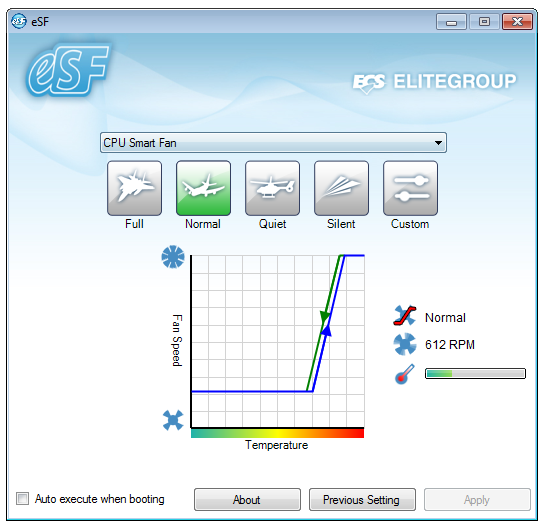
The Smart Fan utility controls the CPU fan header only for the P67H2-A, in either one of the preset modes, or the custom setting allows for hysteresis on the speed up/down modes.
eBLU (BIOS Live Update)
The Live Update software, as mentioned above, could not find the latest version of the BIOS on the ECS servers, and thus I had to search for the BIOS myself.
eDLU (Download Live Update)
The Download Live Update system is not what you think - rather than searching your OS for the state of the drivers, and then probing the ECS servers to check the versions, and asking the user to download them from the software, eDLU is essentially just a link to the driver update page for the P67H2-A on the ECS website.
eGS(Green Saver)
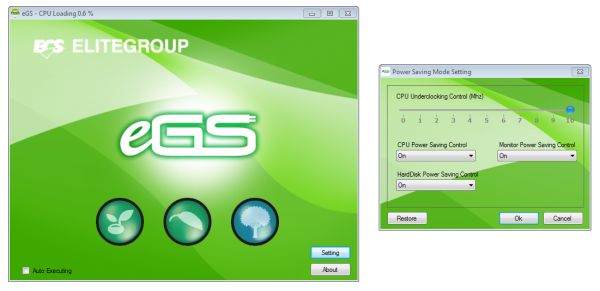
The eGS software is relatively redundant on the Sandy Bridge platform. With this utility, the idea is that the software will reduce the CPU clock speed in idle situations. Sandy Bridge processors do that anyway, reducing to the 16x multiplier when idle.
eOC (Overclocking)
In terms of what we have seen from other overclocking utilities from other manufacturers, eOC is pretty low down on the ladder to begin with - it is essentially software from the socket 775 era software, modified for P67.
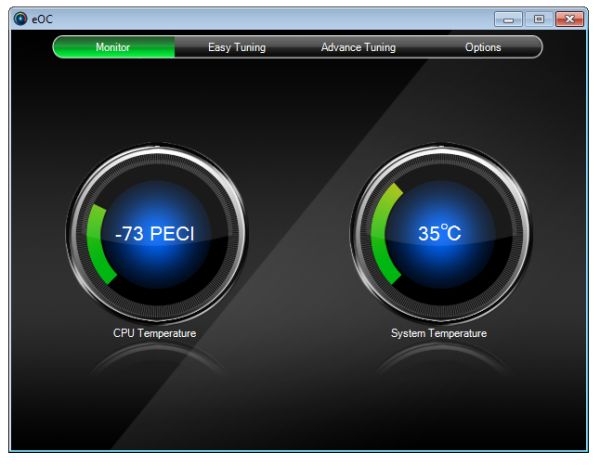
The main page is a simple temperature monitor for the CPU and 'System' temperatures. The CPU temperature is measured in terms of PECI, or the number of degrees before the CPU is throttled due to thermal limitations, rather than an absolute value.
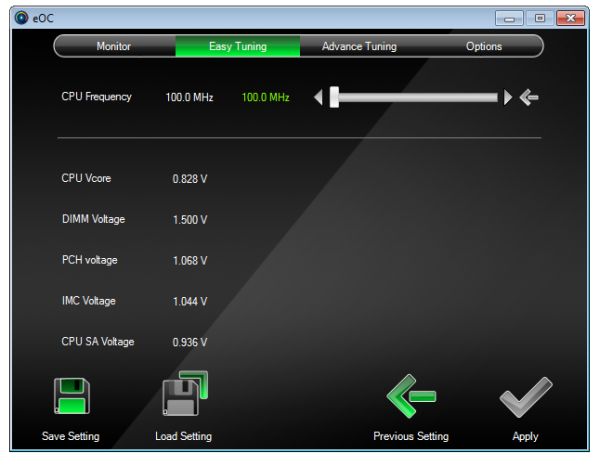
The Easy Tuning tab gives voltages and a CPU Frequency slider, allowing you to adjust the CPU frequency. This slider is the throwback from socket 775 days, when BUS frequencies could reach several hundred MHz—as such, it offers between 100 MHz and 200 MHz in 1 MHz intervals, even though a Sandy Bridge processor can only manage a few MHz due to its integrated clock generator subsystem. Given my stress in getting this option to work when it was on the P67H2-A2, I know now that two obscure BIOS options need to be enabled (both ‘ICC Set Clock Enables’ and ‘Send ICC Lock Registers’) for the eOC software to apply a CPU frequency. As we’re limited to per MHz values, it’s pretty coarsely grained. Also, any change here directly changes the values in BIOS.

The Advance Tuning menu gives you power over the motherboard voltages. These settings work out of the box, but as mentioned previously and found on the P67H2-A2, the issue here is with the CPU voltage. On idle, the CPU will flicker between various low state voltages, and this slider value will flicker too. So if you want to select 1.2 V, you need to make sure what state the CPU is in at the time and apply it at the right moment. If a high voltage is selected at a low CPU state, you could end up with a potentially damaging high voltage in a full CPU load scenario.
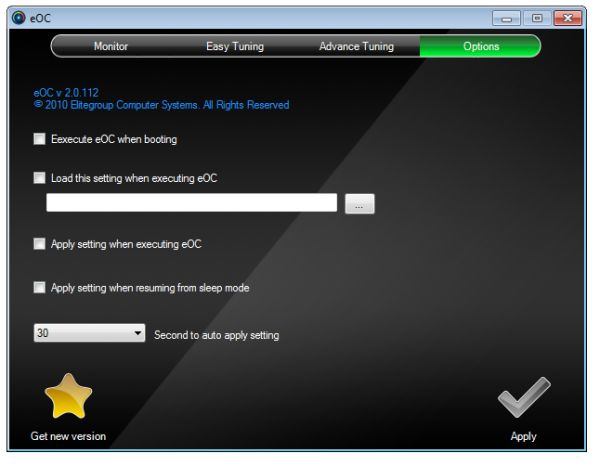
The Options menu, apart from the spelling mistake, doesn’t really do much, apart from enabling a saved eOC to enable itself at bootup.
eJiffy
The eJiffy software is a quick-boot technology which loads the user into a simple Linux interface through which they can access the web. Loading into eJiffy is very quick compared to an SSD and Windows combination, and gives a simple Mozilla type web browser, suitable for when a user wants nothing more than to browse. We covered eJiffy in more detail in our H67 ECS review as it is a pretty neat addition and we rather like it—read here for more details.


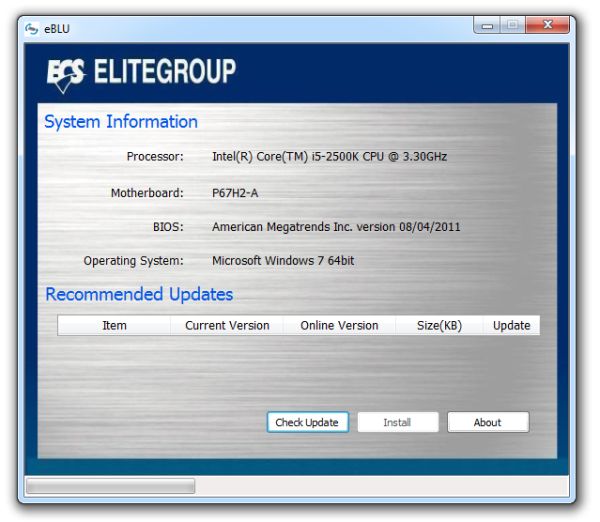
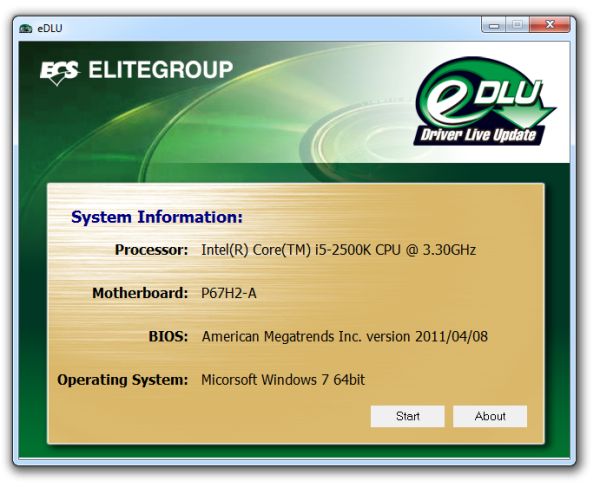
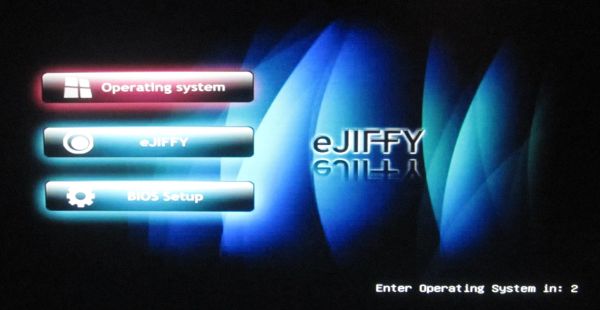








22 Comments
View All Comments
MWilliamson - Thursday, July 21, 2011 - link
An excellent review Ian; I'm impressed by how many combinations you tested under Hydra. While I'm currently not looking to build another system, I have found Hydra to be an interesting concept, and I'm waiting for it to mature to the point where it is valid for all configurations.What I wished to comment on though, was your comment in the Gaming Benchmarks:
"Metro 2033 is the Crysis of the DirectX 11 world (or at least until Crysis 2 is released)..."
Crysis 2 HAS been released, and has been available since April. Granted at the time of release it did not support DirectX 11, due largely in part to it being launched simultaenously on PC and consoles, a recent patch (released June 27th) has added its DirectX 11 feature set, and another patch increased the texture quality for PC gamers, both of which are actually optional, free upgrades. The most recent version, 1.9, also added a demo level which can be run via the in-game console; personally I have no experience with that side of things, since I played through for the storyline, but it is there, and I'd imagine its something you could add to your benchmarking suite, should it suit whatever your requirements are.
IanCutress - Thursday, July 21, 2011 - link
Many thanks on the update :) Not had much time to play games recently, but at some point I want to update the GPU drivers in my reviews also. Updating GPU drivers essentially removes all previous GPU results, so it might be worth having a look at the games I test as well at the same time.Ian
MWilliamson - Thursday, July 21, 2011 - link
You're most welcome, I had thought that was a possibility :)Igen - Thursday, July 21, 2011 - link
Hard to tell from the pics, but are those heatsinks riveted on? Would make mods/repairs difficult.DanNeely - Thursday, July 21, 2011 - link
The southbridge sink has what look like plastic fasteners; I'd assume they're pushpins of some sort. The moftset/etc sinks are harder too tell because of the angle and not being perfectly in focus, but if you look at the fastener in the lower right on the 5th pic the recessed area shows two indents that look like they're in the right spots to be part of a philips head which is otherwise out of sight. A high resolution vertical image/bottom image would really help.Uritziel - Friday, July 22, 2011 - link
MOFTSET lol! I'm going to start saying that :)Death666Angel - Thursday, July 21, 2011 - link
The green color of the ECS mainboard bars in the graphs for gaming makes little sense here, because then we don't know which resolution was used, as the resolution is identified as the colors. Though of course the higher resolution has most likely the lower fps numbers, it still looks odd. :-)Good review though!
HangFire - Thursday, July 21, 2011 - link
You got 3? Wow. My old ECS C2D board had one (two if you count the CPU).ECS has really moved up over the years.
fausto412 - Thursday, July 21, 2011 - link
this solution is junk.dhiiir - Friday, July 22, 2011 - link
I believe that the best motherboard can be ruined with a terrible BIOS or UEFI. UEFI is pretty cool, but if you can't make a good text only implementation, how the hell are you going to make a passable GUI? I'm perfectly happy with a well designed text based UEFI, but I will admit that as much time as I spend with BIOSs and UEFIs, Asus' slick GUI system is clearly in a class by itself. If I were new to the game, I would want something like that on my first build. There just isn't an excuse for terrible BIOS/UEFIs in the year 2011.I like online shopping,but don't know where have a good store to buy . I have a friend said that a shop is very good. -.www.upsfashion.com- I went. Really good. Things are cheap, fashion,. Owner has a good attitude. I am really happy to buy things there.